Beadwork in the ZULU cultural tradition.

All traditional ZULU beadwork, excluding items used by ritual specialists, relates in someway to courtship and marriage. According to Regina Twala (African Studies, Volume 10, no 3 1951, pp 113 - 123), it also helps to regulate behaviour between individuals of opposite gender.
This exclusively feminine craft has an inituitive fluency found only in inspired forms of poetry and visual art. Beadworkers are unware of a "system" such as that imposed upon language by spelling rules and grammar.
However, no true art is without discipline, so ZULU craftswomen accept certain fundamentals:
- Beadwork communicates between unrelated males and females, avoiding the discomfort of direct initial discourse on the sensitive subject of personal relations.
- Beadwork flows from females, the designers and manufactures, to males - their traditional clients.
- Men wear beadwork to show involvement with women they may marry, incestuous implications preclude beaded gifts from mothers, sisters and daugters.
- Beadwork symbolism is encoded within a limited number of colours
and geometric figures.
- Colour symbols have alternative values but those assigned to geometric figures are constant.
- Values assigned to colours are in groups of positive and negative alternatives, excepting white, which has no negative connotation.
- Symbolic coding is influenced by a number of factors
- The combination and arrangement of colours.
- The use and nature of an object.
- The deliberate breaking of rules by which these factors operate.
Beadwork is a by-product of feminine socialization.
Young girls accompany their elder sisters to the local store where they learn to select beads according to colour and quality. Finished products worn by other shoppers are critically discussed so that their social significance is soon understood by the novice.
Men depend on female relatives to explain what they do not understand. Learning by experience, the significance of standard ornaments are by no means beyond them.
They can see whether a woman is uncommited, engaged, married, unmarried, has children or umarried sisters and recognize regional colours which tell them where she comes from,
assuming that she wants these things to be known. Without actually "translating", a man can pick out in a crowd the females he may approach with impunity.
The bead code is deceptively simple.
It utilizes one basic geometric figure - THE TRIANGLE - and, where this craft was studied, a maximum of seven colours.
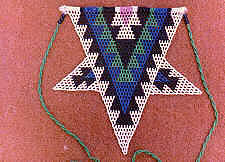
Interpreting beadwork is much like understanding the ZULU language when one has mastered the grammar and aquired a reasonable vocabulary; but meaning is often obscured by the wealth
of poverbs and imagery. This also applies to beadwork, which combines art and linguistic logic.
The Triangle
The three corners of a triangle represents FATHER, MOTHER and CHILD.
As a basic unit of design it can:
- Be inverted, apex pointing downward. This signifies the unfulfilled man principle (Unmarried man) or...
- Be positioned with the apex pointing downwards, signifying the unfulfilled female principle (Unmarried woman).
- Join with another along the base to form a diamond (stylised egg, a universal fertility symbol) representing
the complete female principle (Married Woman).
- Be positioned with apexes meeting, an hourglass shape, symbol of the complete male principle (married man).
In ZULU tradition adulthood comes with mariage, married people have the advantages of
seniority over those who are not. This creates a major male incentive to find jobs and gather what is required as marriage goods.
The large number of single mothers indicate that urban females have been largely emancipated
from this convention, but the importance of marriage as access to adulthood explains the
connection between traditional beadwork and trans-sexual relationships.
Listed below are some of several alternatives in the positive and negative grouping of colours.
| Positive
| Colour
| Negative
| Marriage, Regeneration
| Black
| Sorrow, Despair, Death
| Fidelity, Request
| Blue
| Ill Feeling,Hostility
| Wealth, A Garden,Industry,Fertility
| Yellow
| Thirst, Badness, withering away
| Contentment, Domestic bliss
| Green
| Illness, Discord
| High birth or Rank, An Oath, Promise
| Pink
| Poverty, Laziness
| Physical Love, Strong Emotion
| Red
| Anger, Heartache,Impatience
| Spiritual love, purity, virginity
| White
| ------------------
| | | | | | | |
Social conventions often influence the combinations or arrangements which determine the meaning of colours and geometric figures. As in the "hlonipha" lanuage of ZULU woman (a mode of expression denoting respect for males), certain rules need to be observed in beadwork design.
A girl expressing in beadwork her love for a man would not place the unfulfilled male symbol within its feminine counterpart, but arrange them the other way around, with the unfulfilled male symbol (Triangle , apex down. in white beads) enclosing the unfulfilled female symbol (Triangle apex up, in red beads) as the figure above.
Without negative association, white regularly selects positive meanings in colour arrangements where this may be in doubt. Next to white blue signifies fidelity, so the blue and white combination has become a conventional engagement symbol. Blue, white and black is a standard combination denoting marriage.
There are many ways of combining colours, using them in certain items rather than others, or emphasizing meaning by increasing the number of beads in an appropriate colour.
One well known item IBHEQE (generally sold as a love letter in souvenir shops that supply a small tag with simplistic interpretations of colour), illustrates the operation of the factors listed above.
IBHEQE
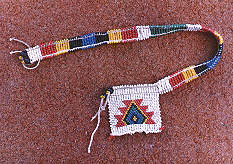
This is a narrow beaded band with a rectangular flap that rests in the hollow of the throat when worn around the neck. The flap incorporates a geometric design composed of triangles in various combinations relating to male/female relationships. The white band holding the flap in place might contain a message in coloured segments composed perhaps as follows:
Black { next to the white of the band, signifying marraige}
Red { next to the black signifying a aching heart }
Yellow { Following the negative black red combination, selects " withering away, pining for " }
Blue { The pivoting colour, followed in opposite sequence by colours preceding it, yellow, red, black} demands response.
The girls is saying : "We are married, but my heart is aching because our love seems to be withering away. When will you return?".
Typically, a rural girl will send this to a young man working in the city if she has not heard from him for some time.
UCU
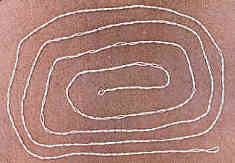
There are some instances in which deliberate breaking of rules is used as a design technique.
An example of such an object is the UCU as shown above.
The object is a five meterlong necklace of white beads, wound around the neck as an engagement token.
It often includes a small tassel of beads in the appropriate blue-and-white combination.
It is unthinkable that it should be fashioned in black, with a tassel of beads in a pale yellow
known in ZULU known as UTHUVI BENKONYANE ("excerta of a calf"), polite alternative
to the cruder four letter word commonly known), but just such an object was taken by a group of young
females, one of whom had been jilted, to the village of the culprit.
In his absence, the object was pointedly wound around the neck of the first dog they found before leaving in silent contempt.
To avoid public denouncement as a coward, the young man subsequently wore it at two wedding ceremonies before selling it to
a tourist :)
A married woman may indicate her availibility for temporary adventure by going without certain
conventional ornaments, such as UMBHAMA.
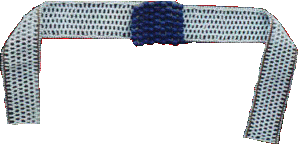 Umbhama is a beaded band worn on ISICHOLO (Married woman`s headdress) above the forehead
It has a central segment of large beads known as AMAGANDA ("eggs" a fertility symbol)
indicating that the wearer has children. Of similar shape and size but without the
AMAGANDA, ISAMBOZO incorporates along its lower edge a row of
tiny triangles, apexes pointing downwards to give it a serrated appearance.
Umbhama is a beaded band worn on ISICHOLO (Married woman`s headdress) above the forehead
It has a central segment of large beads known as AMAGANDA ("eggs" a fertility symbol)
indicating that the wearer has children. Of similar shape and size but without the
AMAGANDA, ISAMBOZO incorporates along its lower edge a row of
tiny triangles, apexes pointing downwards to give it a serrated appearance.
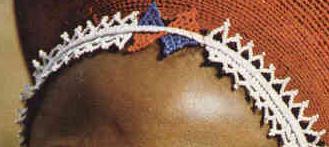
These appendages represent regiments of young warriors, a symbolic reference to numerous male relatives-in-law
whose protection she enjoys. Omission of this item suggests that she is not under "supervision".
Instead, she might wear standard decorations such as iziphenethu
(from the Enlish word , "Pins"). These ornaments carry designs conforming to her married status
but make no reference to her childeren or relatives-in-law. The colour combinations could reveal
a distant domicile, showing that she is "on her own, far from home". She might fix the back of her sweeping headdress
a small beaded disk (inkanyezi), "star") to "catch the eye" as she passes.
Her motives are seldom questioned.
REFERENCES
Stan Schoeman: " Eloquent beads, the semantics of a ZULU art form".
Africa Insight volume 13 no 2 1983.
African Studies volume 27 No`s 2 and 3 1968.
Page last updated 30/6/1996






